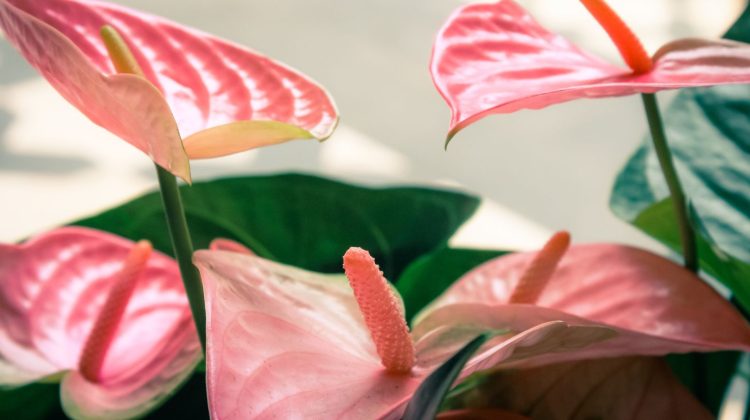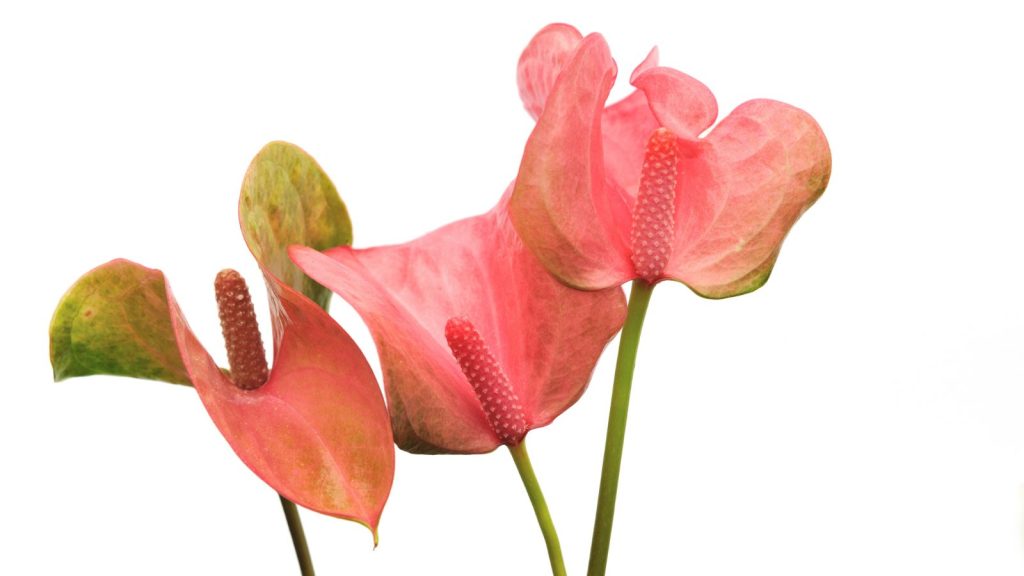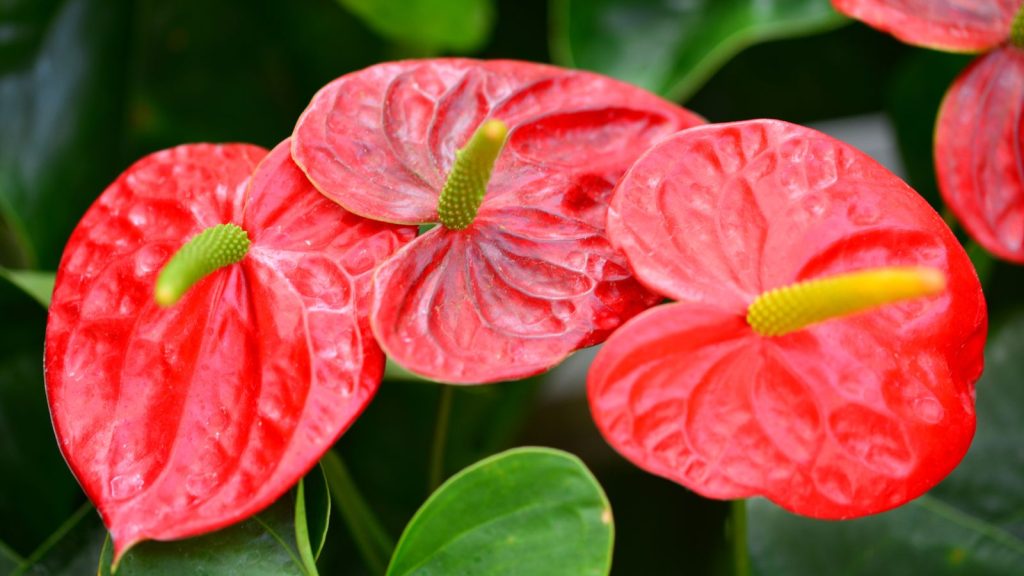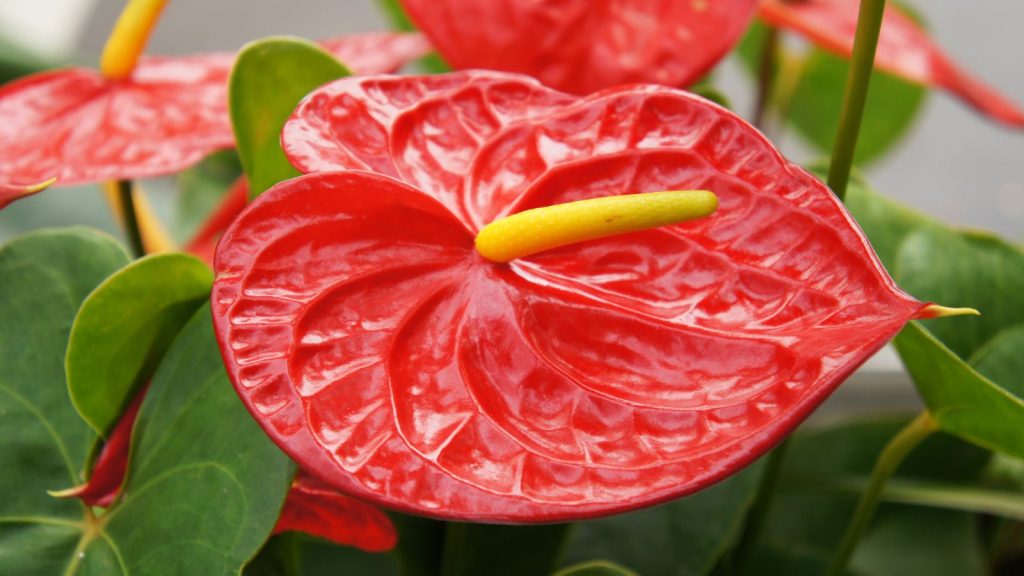
Adding a touch of natural beauty to your living space can be as simple as introducing a vibrant houseplant like the Flamingo Lily.
Known for their striking heart-shaped, shiny flowers and dark green foliage, Flamingo Lilies, or Anthuriums, not only serve as eye-catching decor but also bring a range of benefits to your home.
These tropical plants, specifically the Anthurium andraeanum species, have been grown as indoor plants for their appealing aesthetic and relatively easy care.
Flamingo Lilies can be more than just a pretty addition to your collection of indoor plants. They are believed to contribute to a healthier living environment by purifying the air.
Moreover, in the realm of Feng Shui, anthuriums are thought to draw positive energy and can potentially improve your home’s vibes when placed in the right spot.
Their bright blooms and lush leaves can add life to any room, serving as a visual reminder of the beauty of nature and possibly lifting your spirits.
By including Flamingo Lilies in your living area, you’re not just enhancing the space aesthetically; you might also be fostering a sense of well-being and calm.
Their captivating presence can transform your home into a more inviting, serene sanctuary.
Whether you’re an avid gardener or just looking to brighten up your space with a low-maintenance plant, Flamingo Lilies could be a delightful choice.
In this article, we'll cover
1. The Aesthetic Charm of Flamingo Lilies

Flamingo Lilies, with their vibrant spathes and elegant foliage, bring an enchanting touch to any living space. They are perfect for enriching your home’s décor with natural color and form.
Description of Flamingo Lilies
Flamingo Lilies, scientifically known as Anthurium andraeanum, boast heart-shaped leaves that form a lush green backdrop for the star of the show: the spathes.
These bracts are often mistaken for flowers themselves, thanks to their waxy texture and brilliant hues which can range from red, white, to delicate shades of pink and purple.
Central to the spathe is the spadix, which contrasts with its simplistic form. When in bloom, these plants not only add a pop of color but create a long-lasting visual appeal, as the blooms can endure for weeks on end.
Decorating with Flamingo Lilies
Your Flamingo Lily becomes a statement piece effortlessly due to its vivid spathe, which offers a wide variety of colors. Here are some tips to integrate them beautifully into your home:
- On Coffee Tables: A single Flamingo Lily in a sleek vase can become a sophisticated centerpiece.
- Shelves and Mantles: Group them alongside books or candles to add a cozy yet stylish vibe.
- Bright Corners: Place your plant in a corner area where natural light is ample, but direct sunlight is avoided, to maintain the spathes’ vibrancy.
Position these beautiful plants in the southwest corner of your home or any space where you wish to draw attention.
Their colors and glossy leaves can complement diverse decor styles from minimalist to tropical.
Remember that their heart-shaped leaves and exotic look provide a welcoming ambiance, making them your personal living space piece of nature’s art.
2. Boosting Indoor Air Quality with Flamingo Lilies

Flamingo Lilies, also known as Anthurium andraeanum, aren’t just vibrant houseplants that decorate your living space; they play a crucial role in enhancing the air quality in your home.
Your indoor air can be filled with invisible enemies like formaldehyde, xylene, toluene, and ammonia—common toxins emitted by furniture, paints, and cleaning products.
- Toxin Absorption: These plants act like natural air purifiers. The broad, waxy leaves absorb airborne chemicals through their surface, facilitating the removal of common indoor toxins.
- Humidity Regulation: Flamingo Lilies contribute to a balanced indoor humidity level. They release water vapor during transpiration, which helps maintain a healthy level of high humidity without creating damp conditions.
The benefits of cleaner air in your home are numerous:
- Healthier Lungs: By filtering out pollutants, these plants help ensure that you’re breathing clean air, reducing potential respiratory issues and improving overall lung health.
- Better Sleep: Cleaner air has been linked to improved sleep patterns, making it easier for you to get a good night’s rest.
- Allergy Relief: They can also be a boon for allergy sufferers. Freeing the air from mold spores and other allergens reduces the likelihood of allergic reactions.
By introducing Flamingo Lilies into your space, you not only add a touch of nature’s beauty but also invest in the health and comfort of your environment.
Enjoy the vivid colors and tranquility they bring, all while they tirelessly work to keep your air fresh and toxic-free.
3. Psychological and Emotional Benefits
Flamingo Lilies, with their striking appearance and vibrant colors, bring more than just visual pleasure to your home. They can greatly contribute to a reduction in stress and an overall sense of well-being.
Stress Reduction
Your Flamingo Lily acts as a natural stress reliever, transforming your living space into a more tranquil environment.
Studies suggest that indoor plants like the Flamingo Lily can help mitigate stress, making it a valuable companion in your daily life.
Just being in the presence of these cheerful blooms has the potential to lower your cortisol levels, the hormone often associated with stress.
Enhancing Mood and Well-being
The vibrant colors and lush greenery of Flamingo Lilies can do wonders for your mood.
Their aesthetic appeal is linked to feelings of joy and contentment, helping to create a space where you can feel peaceful and content.
Regular exposure to plants such as these is known to foster a positive atmosphere and promote mental health, crafting a space where joy is encouraged and nurtured.
Productivity and Focus
Incorporating Flamingo Lilies into your workspace can potentially boost your productivity and focus.
The soothing presence of these plants has been associated with an increased ability to concentrate and stay on task.
By providing a calming atmosphere, they can help you maintain a clear head, which is essential when you need to complete important tasks or engage in creative endeavors.
4. Flamingo Lilies as Natural Humidifiers

Flamingo Lilies, also known as Anthuriums, are more than just visually striking; they serve as natural humidifiers for your living space.
If you’re struggling to keep the air in your home from becoming too dry, especially in areas like the bathroom where humidity helps, adding a Flamingo Lily can be an attractive solution.
These tropical plants release moisture into the air through a process known as transpiration. Here’s how it works:
- Water is taken up by their roots.
- It moves through the plant and is eventually released into the air from their leaves.
This natural cycle can slightly increase the humidity level in a room, which has several benefits:
- Improves Air Quality: More humidity means less dry air, which can help reduce problems like dry skin and respiratory issues.
- Comfort: Your space feels more comfortable, especially if you live in a drier climate.
However, it’s crucial to maintain the right balance.
Here’s what you should keep in mind to get the most out of your Flamingo Lily’s humidifying abilities:
- Placement: Position your plant in an area that benefits from a bit more water in the air, like your bathroom.
- No Overcrowding: While one or two plants can be beneficial, too many might contribute to excess moisture, which could lead to other issues.
5. Easy Care for Busy Individuals
Flamingo Lilies, or Anthuriums, offer a vibrant touch to your living space without requiring a lot of your time. These tropical plants are known for their ease of care, making them ideal for individuals with a busy lifestyle.
Basic Care Requirements
Light: Your Flamingo Lily will thrive in bright, indirect sunlight. Direct sunlight can scorch the leaves, so place your plant in a spot that receives filtered light.
Watering: It’s essential to allow the top inch of soil to dry out before watering again.
Use your finger to test the moisture level; when dry, water thoroughly until it drains from the bottom.
Temperature: Flamingo Lilies prefer a warm environment. Aim to keep the temperature between 60°F and 90°F (16°C – 32°C).
Potting: When repotting, choose a container with ample drainage to prevent root rot.
A mix of peat moss and potting soil creates an acidic, well-draining environment for your Anthurium.
Tips for Long-Lasting Blooms
- Humidity: Keep the humidity high to mimic a tropical atmosphere.
- Fertilizing: Feed your plant with a balanced fertilizer every two to three months to support continued blooming.
- Pests and Diseases: Inspect your Flamingo Lily regularly for signs of mealybugs and other pests.
- If you detect any, treat promptly with insecticidal soap.
- Repotting: To encourage continual growth and blooms, repot your Anthurium every two to three years or when you notice it’s becoming root-bound.
6. Considerations for Pet Owners
When you bring Flamingo Lilies into your home, you must consider the safety of your furry friends.
Make yourself familiar with the implications for their health and explore alternative options that keep your living space vibrant and pet-friendly.
Toxicity to Pets
Flamingo Lilies (Anthurium) are stunning with their glossy, heart-shaped leaves and vibrant spathes, but they harbor a secret that’s dangerous to your pets.
They contain calcium oxalate crystals, which are toxic to cats and dogs. If your pet chews or ingests any part of a Flamingo Lily, they could experience oral irritation, drooling, vomiting, and difficulty swallowing.
To prevent accidental ingestion:
- Place Flamingo Lilies out of reach, perhaps on high shelves where pets cannot climb.
- Use hanging planters that suspend the plants away from curious paws.
Safe Alternatives
If you’re seeking non-toxic alternatives to Flamingo Lilies, consider these pet-friendly plants:
- Spider Plant: Hardy and easy to care for, they are completely safe for pets and can even tolerate a bit of neglect.
- Boston Fern: These lush ferns add greenery without posing risks to your pets. They thrive in humid conditions with indirect light.